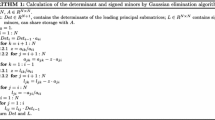Abstract
In the current world that we live in, of rapid growing technology, and especially reliance on the Internet for our daily lively hood (Banking, shopping, entertainment, news), and also with current crimes (Identity-theft, hacking, spyware), computer security is becoming more and more important. By “computer security” we often refer to addressing three important aspects of a computer-related system: Confidentiality, integrity, and availability. Encryption clearly addresses the need for confidentiality of data, both in storage and transmission. However, the use of encryption can be cumbersome and time consuming. It is important to have a fast algorithm to both encrypt and decrypt data as needed. Public key encryption, though secure, is definitely not fast enough to be used for large size data.
We introduce a Parallel Algorithm for computation of inverses of matrices modulo n. This is used in conjunction with Block Ciphers and Hill Ciphers in symmetric encryption and decryption of data for transmission on open lines. Experimental studies were done to compare the run-time of this algorithm on parallel machines, to the traditional one. The new algorithm was found to perform much better than the traditional one, and would be useful to use in encryption/decryption of large sensitive data.
Similar content being viewed by others
References
Pfleeger CP, Pfleeger SL (2003) Security in computing, 3rd edn. Prentice Hall
Diffie W, Hellman M (1976) New directions in cryptography. IEEE Trans Inf Theory 22: 644–654
Stallings W (2003) Cryptography and network security. Prentice Hall
Rivest RL, Shamir A, Adleman LM (1978) A method for obtaining digital signatures and public-key cryptosystems. Communications of the ACM 21(2):120–126. See also U.S. Patent 4,405,829
Merkle R, Hellman M (1978) Hiding information and signatures in Trapdoor Knapsacks. IEEE Trans Inf Theory IT-24(5):525–530
El Gamal A (1985) A public key cryptosystem and signature scheme based on discrete logarithms. IEEE Trans Inf Theory IT-31(4):469–472
Feistal H (1973) Cryptograpy and computer privacy. Sci Am
Shannon C (1949) Communication theory of secrecy systems. Bell Syst Tech J (4)
National Bureau of Standards (1977) Data Encryption Standard, FIPS-Pub.46. National Bureau of Standards, U.S. Department of Commerce, Washington, January 1977
Ehrsam et al (1975) Product block cipher system for data security, Patent 3,962,539, Filed Feb. 24, 1975
Ferguson N, Kelsey J, Lucks S, Schneier B, Stay M, Wagner D, Whiting D (2000) Improved Cryptanalysis of Rijndael, Fast Software Encryption, pp 213–230
Daemen J, Govaerts R, Vandewalle J (1994) A new approach to block cipher design. Fast Software Encryption, Lecture notes in computer science, vol 809, pp 18–32
Eisenberg M (1998) Hill ciphers and modular linear algebra. Mimeographed notes, University of Massachusetts
Weiner MJ (1996) Efficient DES Search Key, Technical Report TR-244, Carleton University. In: Stallings W (ed) Practical cryptography for data internetworks. IEEE Computer Society Press
Daemen J, Rijmen V (2001) The design of rijndael. Springer
Hill LS (1929) Cryptography in an algebraic alphabet. Am Math Mon 36:306–312
Anton H, Rorres C (1991) Elementary linear algebra: applications version, 6 edn. Wiley, New York. See Sect. 11.17
Cormen T, Leiserson CE, Rivest RL, Stein C (2001) Introduction to algorithms, 2nd edn. The MIT Press, McGraw-Hill Book Company
Buzbee BL (1983) The efficiency of parallel processing. Frontiers of Supercomputing, Los Alamost Sci, p. 71, Fall (Also available at http://fas.org/sgp/othergov/doe/lanl/pubs/00326992.pdf)
Ahmdal GM (1967) Validity of the single-processor approach to achieving large scale computing capabilities. In: AFIPS conference proceedings, vol 30, Atlantic City, April 18–20. AFIPS Press, Reston, pp 483–485
Author information
Authors and Affiliations
Corresponding author
Rights and permissions
About this article
Cite this article
Obimbo, C., Salami, B. A Parallel Algorithm for determining the inverse of a matrix for use in blockcipher encryption/decryption. J Supercomput 39, 113–130 (2007). https://doi.org/10.1007/s11227-007-0107-7
Published:
Issue Date:
DOI: https://doi.org/10.1007/s11227-007-0107-7




